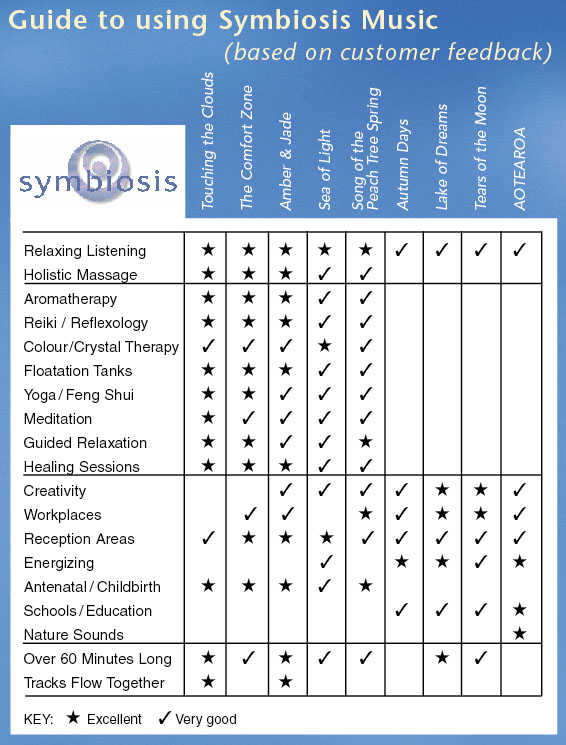Three Articles about Symbiosis:
1. Songs in the Key of Valium
The day is not far off when doctors will prescribe a course of music in preference to tranquillisers. Michael Church meets Clive Williamson, composer of choice at a surgery near you.
Shakespeare bids us mistrust the man who has no music in him. “The motions of his spirit are dull as night, And his affections dark as Erebus”. Music can send us into a solitary trance, or whip us into communal frenzy. Like alcohol, it removes our inhibitions; it binds us together. Expressing intense sadness, it can lift us out of sadness. It’s extraordinarily potent stuff.
Whatever music actually is – and philosophers are still worrying away at the mystery – it’s transmitted by means which are unmysteriously physical. It should be no surprise, therefore that its effects are also physical, and that animals respond to it too. One thinks of birds and hump-backed whales, of snake charming, and of the custom, observed by Thomas Hardy whereby farmers sang to their cows to get a better yield of milk. Orpheus with his lute charmed not only men and beasts, but also trees and rocks. Good vibes are no mere figure of speech. Nor are bad vibes.

Three Articles about Symbiosis:
1. Songs in the Key of Valium
The day is not far off when doctors will prescribe a course of music in preference to tranquillisers. Michael Church meets Clive Williamson, composer of choice at a surgery near you.
Shakespeare bids us mistrust the man who has no music in him. “The motions of his spirit are dull as night, And his affections dark as Erebus”. Music can send us into a solitary trance, or whip us into communal frenzy. Like alcohol, it removes our inhibitions; it binds us together. Expressing intense sadness, it can lift us out of sadness. It’s extraordinarily potent stuff.

Whatever music actually is – and philosophers are still worrying away at the mystery – it’s transmitted by means which are unmysteriously physical. It should be no surprise, therefore that its effects are also physical, and that animals respond to it too. One thinks of birds and hump-backed whales, of snake charming, and of the custom, observed by Thomas Hardy whereby farmers sang to their cows to get a better yield of milk. Orpheus with his lute charmed not only men and beasts, but also trees and rocks. Good vibes are no mere figure of speech. Nor are bad vibes.
The day is not far off when doctors will prescribe a course of music in preference to tranquillisers. Michael Church meets Clive Williamson, composer of choice at a surgery near you.

Shakespeare bids us mistrust the man who has no music in him. “The motions of his spirit are dull as night, And his affections dark as Erebus”. Music can send us into a solitary trance, or whip us into communal frenzy. Like alcohol, it removes our inhibitions; it binds us together. Expressing intense sadness, it can lift us out of sadness. It’s extraordinarily potent stuff.
Whatever music actually is – and philosophers are still worrying away at the mystery – it’s transmitted by means which are unmysteriously physical. It should be no surprise, therefore that its effects are also physical, and that animals respond to it too. One thinks of birds and hump-backed whales, of snake charming, and of the custom, observed by Thomas Hardy whereby farmers sang to their cows to get a better yield of milk. Orpheus with his lute charmed not only men and beasts, but also trees and rocks. Good vibes are no mere figure of speech. Nor are bad vibes.
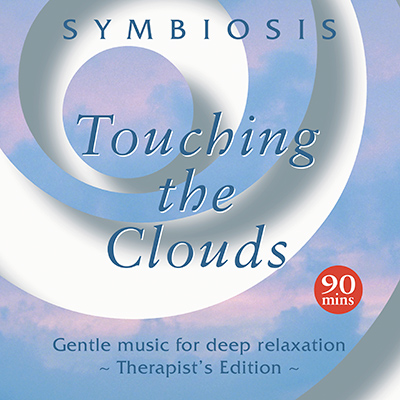
While Caliban speaks of sounds and sweet airs that give delight “and hurt not”, Stravinsky was made “bodily ill” by sounds that had been electronically stripped of their natural overtones. Music can provoke epileptic fits. If it’s low enough and loud enough, it can kill.
But music can also heal, and the Greeks knew this too. Theophrastus, in the third century BC, noted the use of the flute-playing as a cure for sciatica; the Romans believed the flute could salve snake-bite. Current research linking music, mood-swings, and brain function suggests that such beliefs may not have been pure hokum.
Modern music therapists often use a variant on the American Indians “healing song”, inducing their patients to sing their way back to health. They work with stammerers, they treat stroke patients, and they help people suffering from Parkinsonism. In his book Awakenings, Oliver Sacks records the response of patients with movement disorders caused by neurological disease. “The therapeutic power of music,” he says, “may allow an ease of movement otherwise impossible.”
But stress in all its forms is the music therapist’s prime target, and relaxation the key weapon. The music-for-relaxation business has recently been joined by a player whose unorthodox background and radical approach sheds interesting light on this still uncharted terrain.
Clive Williamson is a former BBC sound engineer who now produces his own brand of therapeutic music. He heads an instrumental trio called Symbiosis, whose relaxation album Touching the Clouds has just been taken up by doctors at Bart’s who are researching music’s capacity to relieve pain. In a recent study at Kingston University, in which 11 kinds of music were monitored for their relaxing effect, Symbiosis tied in first place with a piece by Vivaldi. Touching the Clouds – a title borrowed from an eighth-century Chinese poem – is a varied selection of pieces in which a flute, an acoustic guitar, a marimba, and a human voice (Williamson’s) blend with sounds produced on an electronic keyboard.
Great music it’s not, nor does it claim to be. A medieval astronomer would undoubtedly conclude that it was the music of the spheres. Williamson says the aim is not to take the listener over, but to help them “float free”. “We don’t see our music as mesmeric, like gamelan. We see it as a catalyst, non-intrusive sound.”
Good vibes are no mere figure of speech. The effect is floating, spacey, and – as I found when I gave it the couch-test – agreeably narcotic.
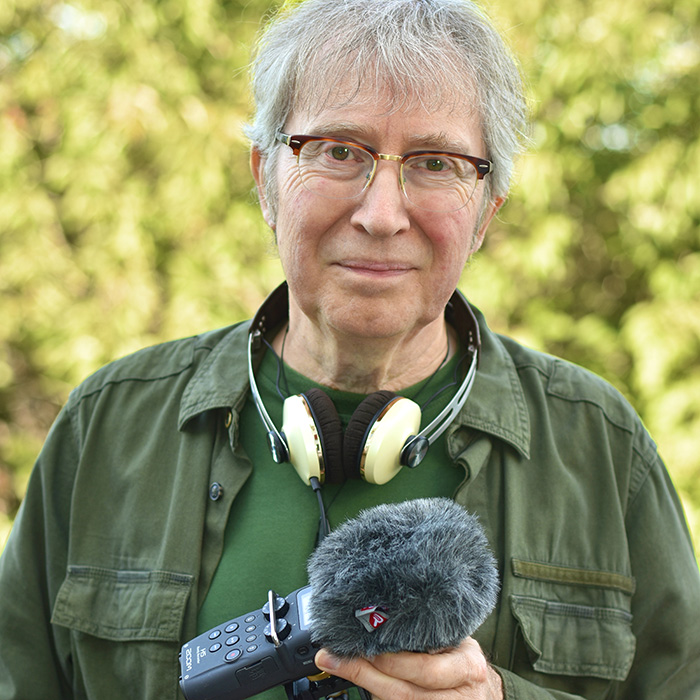
Having grown up in the Sixties under the twin influences of cool jazz and Sibelius, Williamson spent the Seventies dabbling on the fringes of the rock business. His particular obsession was with ambient sound. He watched Brian Eno playing the same piece of music in a wide variety of locations, and noted the variations in how it sounded. He listened to the recordings Paul Horn made, playing his flute inside the Taj Mahal. “The dome made a natural 13-second reverb unit,” says Williamson wide-eyed at the memory. He was inspired to get his own reverb unit.
“I built up a studio, and found ways of creating a collection of sounds which seemed a suitable palette to paint from musically. Experimenting with reverberation, I found I could create the illusion of any space I wanted.” Space – or the illusion of it – seems for some reason to be a crucial element in the pleasure we get from listening to music. “The link between the production of sound and its reception by the ear is tremendously important, and absolutely governs the way you play.” His constant aim was to generate sounds he “felt comfortable with”.
BBC producers who knew what he was up to had periodically pressed his music into service – everything from ecology reports to the diaries of Anaïs Nin – but the turning-point came when he recorded an album with a couple of friends, and released it himself. Having kept his distance from the New Age brigade, he finally gave in and joined them. “They had similar problems to ours in getting their music aired.”
Gradually health centres, dental surgeries, and therapists of all sorts began to use his tapes. He investigated other forms of sound therapy, and gleaned ideas. “I had the chance to try the vibro-acoustic bed, which is used to reduce the tension in spasticity. You feel the lowest frequencies in your heels and as the pitch rises you feel it progressively higher in your body. You can pin down, through your body’s perception, where the frequencies are.” As it happens, the percussionist Evelyn Glennie, who is profoundly deaf, talks of perceiving music in precisely these terms. She “listens” with the speakers pressed against her stomach or her neck.
There is something curiously modest about Williamson’s crusade; emptying his music of anything unexpected, anything which smacks of logic or the will, any stress or urgency, creating a sound-world no more “interesting” than a lava lamp. But this is a game as old as the hills. Film composers are adept at it. There are jazz players, rock singers, and composers galore – though they might not thank you for saying so – who could fit the bill. Gorecki? Gavin Bryars? Michael Nyman would have to be excluded: he’s boring enough, but communicates an unsleeping urgency. Supermarket muzak designed to stimulate the acquisitive urge, would likewise not qualify. Gregorian chant, on the other hand, would do fine.
“Classical music for relaxation” is already a record industry marketing concept. Williamson’s long-term hope is that your average GP, when faced with a patient suffering from stress, may one day prescribe not pills but a relaxation tape. Well, quite: it could make him as rich as Croesus. But it’s a thought worth thinking. Throw away that valium, and listen to some music instead. Or better still, make your own music. Join a choir, dig out that guitar, pick up a recorder. It won’t do any harm.
Reproduced by kind permission of Michael Church. © Michael Church, 1995.
Originally published in the Independent newspaper, 15th January 1995

While Caliban speaks of sounds and sweet airs that give delight “and hurt not”, Stravinsky was made “bodily ill” by sounds that had been electronically stripped of their natural overtones. Music can provoke epileptic fits. If it’s low enough and loud enough, it can kill.
But music can also heal, and the Greeks knew this too. Theophrastus, in the third century BC, noted the use of the flute-playing as a cure for sciatica; the Romans believed the flute could salve snake-bite. Current research linking music, mood-swings, and brain function suggests that such beliefs may not have been pure hokum.
Modern music therapists often use a variant on the American Indians “healing song”, inducing their patients to sing their way back to health. They work with stammerers, they treat stroke patients, and they help people suffering from Parkinsonism.
In his book Awakenings, Oliver Sacks records the response of patients with movement disorders caused by neurological disease. “The therapeutic power of music,” he says, “may allow an ease of movement otherwise impossible.”
But stress in all its forms is the music therapist’s prime target, and relaxation the key weapon. The music-for-relaxation business has recently been joined by a player whose unorthodox background and radical approach sheds interesting light on this still uncharted terrain.
Clive Williamson is a former BBC sound engineer who now produces his own brand of therapeutic music. He heads an instrumental trio called Symbiosis, whose relaxation album Touching the Clouds has just been taken up by doctors at Bart’s who are researching music’s capacity to relieve pain.
In a recent study at Kingston University, in which 11 kinds of music were monitored for their relaxing effect, Symbiosis tied in first place with a piece by Vivaldi. Touching the Clouds – a title borrowed from an eighth-century Chinese poem – is a varied selection of pieces in which a flute, an acoustic guitar, a marimba, and a human voice (Williamson’s) blend with sounds produced on an electronic keyboard.
Good vibes are no mere figure of speech. The effect is floating, spacey, and – as I found when I gave it the couch-test – agreeably narcotic.

Great music it’s not, nor does it claim to be. A medieval astronomer would undoubtedly conclude that it was the music of the spheres. Williamson says the aim is not to take the listener over, but to help them “float free”. “We don’t see our music as mesmeric, like gamelan. We see it as a catalyst, non-intrusive sound.”
Having grown up in the Sixties under the twin influences of cool jazz and Sibelius, Williamson spent the Seventies dabbling on the fringes of the rock business. His particular obsession was with ambient sound. He watched Brian Eno playing the same piece of music in a wide variety of locations, and noted the variations in how it sounded. He listened to the recordings Paul Horn made, playing his flute inside the Taj Mahal. “The dome made a natural 13-second reverb unit,” says Williamson wide-eyed at the memory. He was inspired to get his own reverb unit.
“I built up a studio, and found ways of creating a collection of sounds which seemed a suitable palette to paint from musically. Experimenting with reverberation, I found I could create the illusion of any space I wanted.” Space – or the illusion of it – seems for some reason to be a crucial element in the pleasure we get from listening to music. “The link between the production of sound and its reception by the ear is tremendously important, and absolutely governs the way you play.” His constant aim was to generate sounds he “felt comfortable with”.
BBC producers who knew what he was up to had periodically pressed his music into service – everything from ecology reports to the diaries of Anaïs Nin – but the turning-point came when he recorded an album with a couple of friends, and released it himself. Having kept his distance from the New Age brigade, he finally gave in and joined them. “They had similar problems to ours in getting their music aired.”
Gradually health centres, dental surgeries, and therapists of all sorts began to use his tapes. He investigated other forms of sound therapy, and gleaned ideas. “I had the chance to try the vibro-acoustic bed, which is used to reduce the tension in spasticity. You feel the lowest frequencies in your heels and as the pitch rises you feel it progressively higher in your body. You can pin down, through your body’s perception, where the frequencies are.” As it happens, the percussionist Evelyn Glennie, who is profoundly deaf, talks of perceiving music in precisely these terms. She “listens” with the speakers pressed against her stomach or her neck.
There is something curiously modest about Williamson’s crusade; emptying his music of anything unexpected, anything which smacks of logic or the will, any stress or urgency, creating a sound-world no more “interesting” than a lava lamp. But this is a game as old as the hills. Film composers are adept at it. There are jazz players, rock singers, and composers galore – though they might not thank you for saying so – who could fit the bill. Gorecki? Gavin Bryars? Michael Nyman would have to be excluded: he’s boring enough, but communicates an unsleeping urgency. Supermarket muzak designed to stimulate the acquisitive urge, would likewise not qualify. Gregorian chant, on the other hand, would do fine.
“Classical music for relaxation” is already a record industry marketing concept. Williamson’s long-term hope is that your average GP, when faced with a patient suffering from stress, may one day prescribe not pills but a relaxation tape. Well, quite: it could make him as rich as Croesus. But it’s a thought worth thinking. Throw away that valium, and listen to some music instead. Or better still, make your own music. Join a choir, dig out that guitar, pick up a recorder. It won’t do any harm.
Reproduced by kind permission of Michael Church. © Michael Church, 1995.
Originally published in the Independent newspaper, 15th January 1995
2. Symbiosis: Perfecting the Art of Relaxation
by Brian Lee (for Caduceus magazine)
Many musicians think that producing an album of relaxing music is just a matter of playing something slow and gentle on a synthesizer. They take the usual recipe of flutes, angels and bell sounds, avoiding anything too challenging and the result is often bland and at worst irritating. But since 1986 Symbiosis has been consciously perfecting the art of creating seamless relaxing music that does not intrude, whilst sustaining musical interest.
For example, if you use a slow movement from a Baroque concerto as background music when giving a massage, the piece may create a supportive and relaxing space but it will undoubtedly end before the massage does, leaving an awkward gap before the next track starts. Also the piece will carry emotional baggage with it. Albinoni’s famous Adagio, for example, is deliciously calm, but it is also sad to the point of being moving. Do you want that to be part of the session? Moreover, the Albinoni has been used as a film score, so listening to it may bring to mind unwelcome images such as Australian and New Zealand soldiers dying on the beaches of Gallipoli.
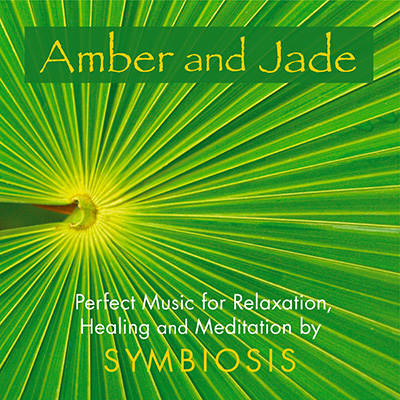
2. Symbiosis: Perfecting the Art of Relaxation
by Brian Lee (for Caduceus magazine)
Many musicians think that producing an album of relaxing music is just a matter of playing something slow and gentle on a synthesizer. They take the usual recipe of flutes, angels and bell sounds, avoiding anything too challenging and the result is often bland and at worst irritating. But since 1986 Symbiosis has been consciously perfecting the art of creating seamless relaxing music that does not intrude, whilst sustaining musical interest.
For example, if you use a slow movement from a Baroque concerto as background music when giving a massage, the piece may create a supportive and relaxing space but it will undoubtedly end before the massage does, leaving an awkward gap before the next track starts.

Also the piece will carry emotional baggage with it. Albinoni’s famous Adagio, for example, is deliciously calm, but it is also sad to the point of being moving. Do you want that to be part of the session? Moreover, the Albinoni has been used as a film score, so listening to it may bring to mind unwelcome images such as Australian and New Zealand soldiers dying on the beaches of Gallipoli.
2. Symbiosis: Perfecting the Art of Relaxation
by Brian Lee (for Caduceus magazine)
Many musicians think that producing an album of relaxing music is just a matter of playing something slow and gentle on a synthesizer. They take the usual recipe of flutes, angels and bell sounds, avoiding anything too challenging and the result is often bland and at worst irritating. But since 1986 Symbiosis has been consciously perfecting the art of creating seamless relaxing music that does not intrude, whilst sustaining musical interest.
For example, if you use a slow movement from a Baroque concerto as background music when giving a massage, the piece may create a supportive and relaxing space but it will undoubtedly end before the massage does, leaving an awkward gap before the next track starts. Also the piece will carry emotional baggage with it. Albinoni’s famous Adagio, for example, is deliciously calm, but it is also sad to the point of being moving. Do you want that to be part of the session? Moreover, the Albinoni has been used as a film score, so listening to it may bring to mind unwelcome images such as Australian and New Zealand soldiers dying on the beaches of Gallipoli.

Since their first albums from 1988, Song of the Peach Tree Spring and Tears of the Moon, Symbiosis have been listening carefully to what therapists and holistic practitioners need from a piece of music. This led them to distinguish between and to focus the two types of music they were producing. On the one hand there are the pieces that create an instant atmosphere, the type of mood-inducing music that is perfect for visualisation and dreaming away on a virtual journey, the sort of sound pieces that film directors are looking for. On the other hand there is music that consciously and deliberately focuses on the art of relaxation in the context of a healing or therapeutic session.
No Tunes
This type of music demands the ability to play very slow improvised pieces without identifiable tunes. As group leader and sound engineer Clive Williamson explained to me, tunes don’t help with the process of deep relaxation. A melody will inevitably have a pattern of tension and the expectation and ultimate delivery of resolution, which goes against the intention of being non intrusive and emotionally neutral. Rather, the members of Symbiosis improvise with sound; Clive creating ambient soundscapes which flautist John Hackett and guitarist Richard Bolton populate with musical figures. The role of the musician is to stay in the background in an ego-less way, which is as difficult for musicians as for anyone.
Their album Touching the Clouds took two years of work. It has paid off. A study at Kingston University showed that listening to Touching the Clouds significantly reduced the heartbeat rate and therefore helped people to relax. These tests led to the use of Symbiosis’ music at St Bartholomew’s hospital in London as part of a study to see if relaxation tapes can be used with – or even instead of – conventional medication to treat some stress-related problems.
To balance their creation of relaxing music the band has also played live, in contrast to many studio-bound ‘New Age’ musicians. Playing in front of an audience has clarified what works musically since pure ambient music is too gentle for a live set. It led them to experiment along different paths resulting in two albums: the atmospheric Lake of Dreams; and Autumn Days, a musical world journey using Spanish guitars, bossa nova rhythms, flutes and other acoustic instruments from Africa, India and South America. Clive describes Autumn Days as being tuneful, energising and “perfect for the therapist to enjoy at the end of a hard day.”
Music for Spaces
The next step in their musical development was to produce music for the healing album by Denise Linn, Angels! Angels! Angels! It was so well received that the music for Phoenix Rising followed, which concerns rising above limitations. Denise’s spoken meditation uses affirmations to encourage personal empowerment and a positive, healthy image of the self. Symbiosis was required to form musical images around the words, to create a background soundscape for the four meditations that appear on that album and also to create music to go into the spaces in the meditation where the listener is left on their own to process a particular point. This experience of ‘pouring music into these spaces’ as Clive put it, has deepened their awareness of the place of music in relaxation and healing. Six of the pieces from that album have been developed into the ‘Phoenix Suite’ on their subsequent album Amber and Jade. This includes the track which, of all their music, most approaches perfection: The Beauty Within.
Symbiosis are not trying to express great music out of personal suffering. Their aim is not to create a cosmetic spirituality with a show of synthesized angelic voices, as many so called ‘New Age’ albums do. In a genre that is often happy to package the same musical formula according to whatever image is fashionable, they bring a special consciousness and musicality. Their work has a rare honesty that grows out of their wish to do nothing more than create music that complements the therapist’s work.
What they have achieved on Amber and Jade is an album that sustains a wealth of musical invention whilst remaining calm, relaxing, emotionally neutral and non-intrusive. It works because their purpose and intent are clear.
Many thanks to Brian Lee for his permission to reproduce the above article, which first appeared in Issue 38 of Caduceus magazine. (Winter 1997/8)
Their work has a rare honesty that grows out of their wish to do nothing more than create music that complements the therapist’s work…
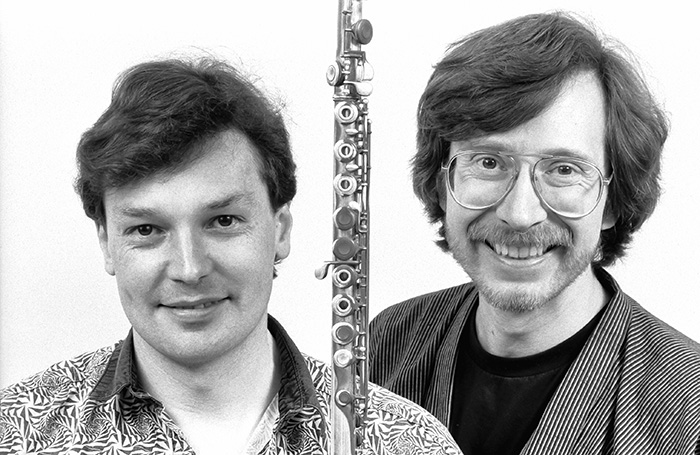
John & Clive

Richard
3. Choosing and Using Music for Relaxation and Complementary Therapies
by Clive Williamson of Symbiosis
Sound plays a powerful role in our lives: playing the ‘right’ music can affect us in very positive ways by energizing, relaxing, nurturing, or providing emotional release. So it’s important to choose appropriate music to bring into our homes, work spaces and therapy rooms. We notice instantly when a noise is too loud, or if music is discordant or fails to fit our mood, but happily the reverse is also true. Music can be a great comfort, and can bring a real sense of ‘suspending time’ from thinking about the cares of life. It plays other important roles too, such as changing a mood, bringing people together socially, masking unwanted sound from neighbours or the environment, and even helping to disguise the irritating effects of tinnitus.
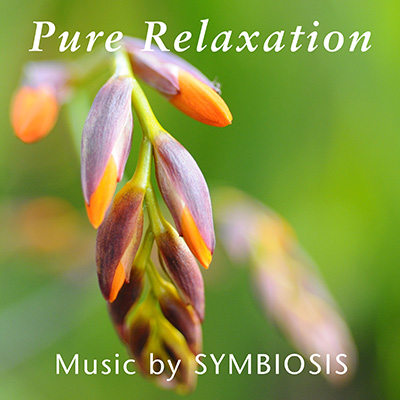
3. Choosing and Using Music for Relaxation and Complementary Therapies
by Clive Williamson of Symbiosis
Sound plays a powerful role in our lives: playing the ‘right’ music can affect us in very positive ways by energizing, relaxing, nurturing, or providing emotional release. So it’s important to choose appropriate music to bring into our homes, work spaces and therapy rooms. We notice instantly when a noise is too loud, or if music is discordant or fails to fit our mood, but happily the reverse is also true.
Music can be a great comfort, and can bring a real sense of ‘suspending time’ from thinking about the cares of life. It plays other important roles too, such as changing a mood, bringing people together socially, masking unwanted sound from neighbours or the environment, and even helping to disguise the irritating effects of tinnitus.

3. Choosing and Using Music for Relaxation and Complementary Therapies
by Clive Williamson of Symbiosis
Sound plays a powerful role in our lives: playing the ‘right’ music can affect us in very positive ways by energizing, relaxing, nurturing, or providing emotional release. So it’s important to choose appropriate music to bring into our homes, work spaces and therapy rooms. We notice instantly when a noise is too loud, or if music is discordant or fails to fit our mood, but happily the reverse is also true. Music can be a great comfort, and can bring a real sense of ‘suspending time’ from thinking about the cares of life. It plays other important roles too, such as changing a mood, bringing people together socially, masking unwanted sound from neighbours or the environment, and even helping to disguise the irritating effects of tinnitus.

Finding the right music
Symbiosis have discovered a number of factors which consistently give the best results when making music for relaxation. Most important is the choice of instruments. Real instruments – especially flutes, acoustic guitar and carefully selected keyboards – create a very gentle soundscape and bring a sense of ‘air’ and life into the music. Additionally, our research indicates that creating music without any obvious tunes or patterns helps to produce very deep relaxation. Tunes seem to tie up the mind, as do drum beats, which actively encourage a continuous response in the listener. And if you go the ‘relaxing classics’ route there is a danger that some pieces will have heavy emotional ‘baggage’ attached: whereas using music written specially for the purpose of relaxation seems to keep the mind clearer and gives better results!
Other things that Symbiosis, as composers, can do to help are: using a very slow tempo; avoiding unexpected changes; and making music flow easily from one piece to another without an obvious break. The ultimate challenge is to write slow music without any tunes and still make it enjoyable and musically valid! Judging by the feedback from those already using our albums, our efforts have been a great success!
Advice for Therapists
Many therapists find that playing music helps to establish a welcoming atmosphere in treatment rooms, and if clients are comfortable with music during the session they usually talk less and are more receptive to treatment. When massage practitioners use CDs they avoid getting oil on their sound equipment or having to stop to change the music, a vital factor for professional users is to find albums which are long enough to play continuously without repeating through a one hour session. Hearing the same album time and time again, practitioners soon notice the benefits of having a musical atmosphere which supports their work without any obvious tunes to learn and be bored by! Albums which play throughout an entire treatment and evolve slowly during the session give the added bonus of allowing practitioners to maintain a subtle sense of timing during their work.
How Symbiosis Can Help
Applying all these ideas, Symbiosis have produced a number of albums with deep relaxation and practitioners in mind. Touching the Clouds was our first album created specially for holistic therapies, running 72 minutes on CD or 90 minutes on cassette (and now available as download). It has a spacious and Zen-like quality much loved by practitioners and general listeners alike, and has been particularly successful in massage, reiki, yoga, healing and meditation. Amber and Jade is now rivalling Touching the Clouds in popularity, with its slightly more ‘Western’ pastoral sounds and high suitability for massage, aromatherapy, reflexology and all forms of relaxing listening. Both these albums have been written with tracks flowing one into another: the musical equivalent of a massage therapist maintaining contact with the client through a session!
The Sea of Light and Song of the Peach Tree Spring CDs both play for over an hour, have enthusiastic listeners from a broad range of uses, and are very well-suited to holistic work and individual or group meditation. The Comfort Zone combines the gentlest of tracks from all our albums, is an excellent choice for therapists and makes a perfect gift to yourself or any friend or relative who is suffering from an overdose of the stresses of life!
For more information about the suitability of Symbiosis albums for different uses, see the chart below:
